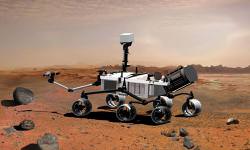NASA’s over budget Mars Science Laboratory mission, scheduled for a 2009 launch, may be delayed due to problems with the atmospheric re-entry shield design. A new shield will cost up to $30 million, adding to the $1.8 billion price tag, $165 million more than planned. The mission uses innovative landing technologies and is powered by a mini-nuclear reactor, giving it the ability to travel faster and carry a bigger payload over the Martian terrain. This new setback may postpone the launch until 2011.
As the most advanced part of NASA’s Mars Exploration Program, the Mars Science Laboratory will be the most ambitious mission yet. Powered by a nuclear reactor, the large rover (measuring 9-foot long) will have a greater range and will be able to carry out a massive range of experiments on the planets surface. Complementing missions such as the Mars Exploration Rovers (Spirit and Opportunity, still making history as the longest ever Mars rover mission) and Phoenix (scheduled to arrive on May 25th this year), The Mars Science Laboratory will continue to see whether Mars might be able to sustain microbial life, take samples and analyse rocks plus provide us with detailed information about the landscape, atmosphere and whether water exists in large quantities. This is all in preparation of future manned exploration of the Red Planet.
Due to the adventurous nature of the project, there have been some setbacks and over-spending. The most recent problem focuses on the heat shield protecting the lander from extreme heat as it enters the atmosphere. The original design uses a similar shield to the one that protects the Shuttle’s external fuel tanks, but in tests engineers found that it could suffer catastrophic damage. Now, NASA has switched to a stronger cocoon-like shield similar to the one that protected the Stardust mission returning comet samples to Earth in 2006. But development and construction isn’t cheap, setting NASA back another $30 million.
“It kind of interrupts what has been an incredibly successful sequence of missions.” – John Mustard, Brown University Geologist and head of an advisory group giving scientific input on future Mars projects.
Many scientists believe that such ambitious projects will always stumble across unforeseen problems and expenses, after all, space agencies such as NASA are doing something extraordinary, spearheading mankind’s exploration of space. This is frustrating however, as the Mars Exploration Program has surpassed all expectations so far and it appears that the Mars Science Lab is slowing down progress, prompting worries that costs will soar should the launch date be postponed any longer.
Source: Physorg


didnt the stardust mission crash during reentry
Disappointing, but with the incredible run of success in missions to Mars lately, I guess not totally unexpected…
LLDiaz:
It wasn’t Stardust that crashed it was Genesis.
http://en.wikipedia.org/wiki/Genesis_spacecraft
Even so, Genesis crashed because of a faulty ‘deceleration sensor’ not because of the heat shield. It wasn’t a total failure because a lot of the samples were still recovered.
For $30 million, they’ll delay a mission that will continue to cost millions just sitting on ground. There’s the mission controller, storage costs, continued testing costs, costs for rescheduling. I hope they aren’t being penny wise and pound fooling here!
Even if the heat shield costs another $100 million because of all of the costs you mention, it would still be worth it so that the $1.8 BILLION mission doesn’t die on reentry. A catastrophic failure means a firework show that no one will ever see and exactly zero science results.
Its always going to be a learning curve,but they’ll solve it a worth while project,it would be nice to get going in 2009,we’re on such a role,maybe congress will loosen their purse strings.
I don’t think it’s the money that will possibly cause the delay, but the extra time to design, build and test the new shield. If they can’t use the shield they have now, they better take their time to test (and modify where needed) the new one, otherwise we might loose the 1,8 Billion during reentry. I rather wait two more years in that case…